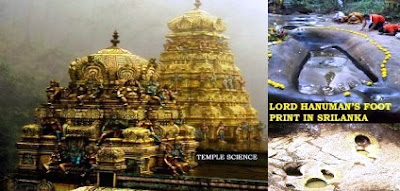Sri Seethai Amman temple, this historical temple is located in the village called Seeta Eliya, in the Ashoka Forest (Ashoka vatika), in Sri Lanka, there is a stream of water in this forest. There is also the stone where, it is believed mother Sita sat, cried, meditated, and would pray, her husband Prabhu Sri Rama, would come and rescue her. As the Ramayana Ithihasa connects both India and Sri Lanka, the Sri Lanka Tourism Development Authority (SLTDA) has discovered more than 40 historical sites relating to the Ramayana by their efficient excavation teams and they are trying hard to promote that Spiritual Tourism regarding the history of India and Sri Lanka.
There had been three idols discovered, one is of maa Sita, thus confirming this is indeed the place where mother Sita was held a prisoner, and also the place where Lord Hanuman rested after the battle with the Ravana, to rescue maa Sita. This discoveries proves this place definitely has a historical essence. This a good, and beautiful site to visit by Hindu devotees, also the epic Ramayana is well known, as the story of maa Sita being kidnapped by the Dasanan Ravana, and her rescue, no need to explain this story here, all Indians, and Hindus know.
It is reported that Ramayana was recognized as the 'Ithihasa' of Bharathvarsha and the then ancient Bharathvarsha accounted of Sri Lanka, Pakistan, Afghanistan and even Iran nowadays. It is therefore very normal that Sri Lanka would recognize Ramayana as its Ithihasa, too. In Sanskrit ' Ithihasa' means ‘It thus happened’ and so Ramayana must be a true story. And of course it is not merely a story of ancestors it is the subject of emotion, devotion, attachment, passion and sentiment of root origin both for India and Sri Lanka. Hope in near future we will find more collaborating discoveries and promotion of Ramayana sites by the governments both countries.
D. K. Hari (Author), D. K. Hema Hari (Author) claimed in their book, Ramayana In Lanka, ‘Ramayana as a text is also geographically very correct. Every site on Rama’s route is still identifiable and has continuing traditions in the form of temples or other landmarks to commemorate Rama’s visit. No author could have travelled so far and wide just to concoct a story and even if so, it could not have had such a geographical credibility to become a local folklore across the subcontinent of India and Lanka’.
Pooja time in Sri Seethai Amman temple:
Morning: 8AM to 1PM
Afternoon : 2PM to 6:30PM
This is mentioned in the famous ancient historical document Ramayana. Many believe this story is true, and this temple is a historical site. Many devotees come to visit and pray. There is also another temple dedicated to Lord Hanuman, outside Mother Sita's temple. There are also footprints of different sizes, some of those foot prints belong to mother Sita. The other foot prints, and of different sizes belong to Lord Hanuman, and his power of is proven by his foot prints of different size, meaning Lord Hanuman is powerful enough to take any size he wants. Lord Hanuman was the owner of astha siddhis and nava nidhi.
Most Hindu temples, whether in India or other country like Sri Lanka, or other places have charming history, and legends, this temple is no exception. The stream of mineral water, is an area that was cursed by mother Sita, to this present date, on this area, the water has no taste, it is recommended not to drink this tasteless particular area water, but drink from other places, and of course from the down stream water. The Ramayana mentions, that maa Sita also used to bathe in this stream of water.There had been three idols discovered, one is of maa Sita, thus confirming this is indeed the place where mother Sita was held a prisoner, and also the place where Lord Hanuman rested after the battle with the Ravana, to rescue maa Sita. This discoveries proves this place definitely has a historical essence. This a good, and beautiful site to visit by Hindu devotees, also the epic Ramayana is well known, as the story of maa Sita being kidnapped by the Dasanan Ravana, and her rescue, no need to explain this story here, all Indians, and Hindus know.
It is reported that Ramayana was recognized as the 'Ithihasa' of Bharathvarsha and the then ancient Bharathvarsha accounted of Sri Lanka, Pakistan, Afghanistan and even Iran nowadays. It is therefore very normal that Sri Lanka would recognize Ramayana as its Ithihasa, too. In Sanskrit ' Ithihasa' means ‘It thus happened’ and so Ramayana must be a true story. And of course it is not merely a story of ancestors it is the subject of emotion, devotion, attachment, passion and sentiment of root origin both for India and Sri Lanka. Hope in near future we will find more collaborating discoveries and promotion of Ramayana sites by the governments both countries.
D. K. Hari (Author), D. K. Hema Hari (Author) claimed in their book, Ramayana In Lanka, ‘Ramayana as a text is also geographically very correct. Every site on Rama’s route is still identifiable and has continuing traditions in the form of temples or other landmarks to commemorate Rama’s visit. No author could have travelled so far and wide just to concoct a story and even if so, it could not have had such a geographical credibility to become a local folklore across the subcontinent of India and Lanka’.
Pooja time in Sri Seethai Amman temple:
Morning: 8AM to 1PM
Afternoon : 2PM to 6:30PM

No comments:
Post a Comment
Please do not enter any spam link in the comment box. Thanks for reading our articles.